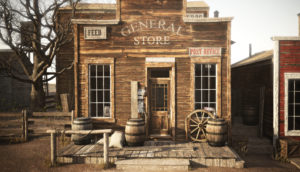Read the Following Selection
Read the following selection, or click on the play button below to listen aloud.
A General Store in the 1800s

In the 1800s, most small towns had a general store. It was often the only place where people could shop. At a general store, people bought things they could not make or grow themselves.
Here are some of the things for sale at a general store:
Category |
Examples |
Groceries |
Coffee beans, spices, sugar, eggs, milk, butter, fruit, vegetables, cheese, honey |
Medicines |
Pills or syrups for problems such as upset stomach and headache |
Sewing supplies |
Cloth, pins, needles, thread, buttons |
Items for the house |
Pots, pans, candles, plates, dishes |
Farming supplies |
Rope, shovels, and other equipment for farmers |
Treats for children |
Hard candy, dolls and other toys |
People often traded to get things they needed. For example, a farmer’s hens might lay more eggs than the farmer’s family needed. He might trade the eggs for some sugar and honey. Then the general store could sell the eggs to someone else.
Many general stores had a post office. People could buy stamps, send letters, and pick up letters at the post office.
The general store was also a meeting place. People would talk and share news with others who lived in the community. Homes did not have telephones back then, so people could not call their friends to stay in touch.
Now, show what you know!
Complete some questions about the reading selection by clicking “Begin Questions” below.









